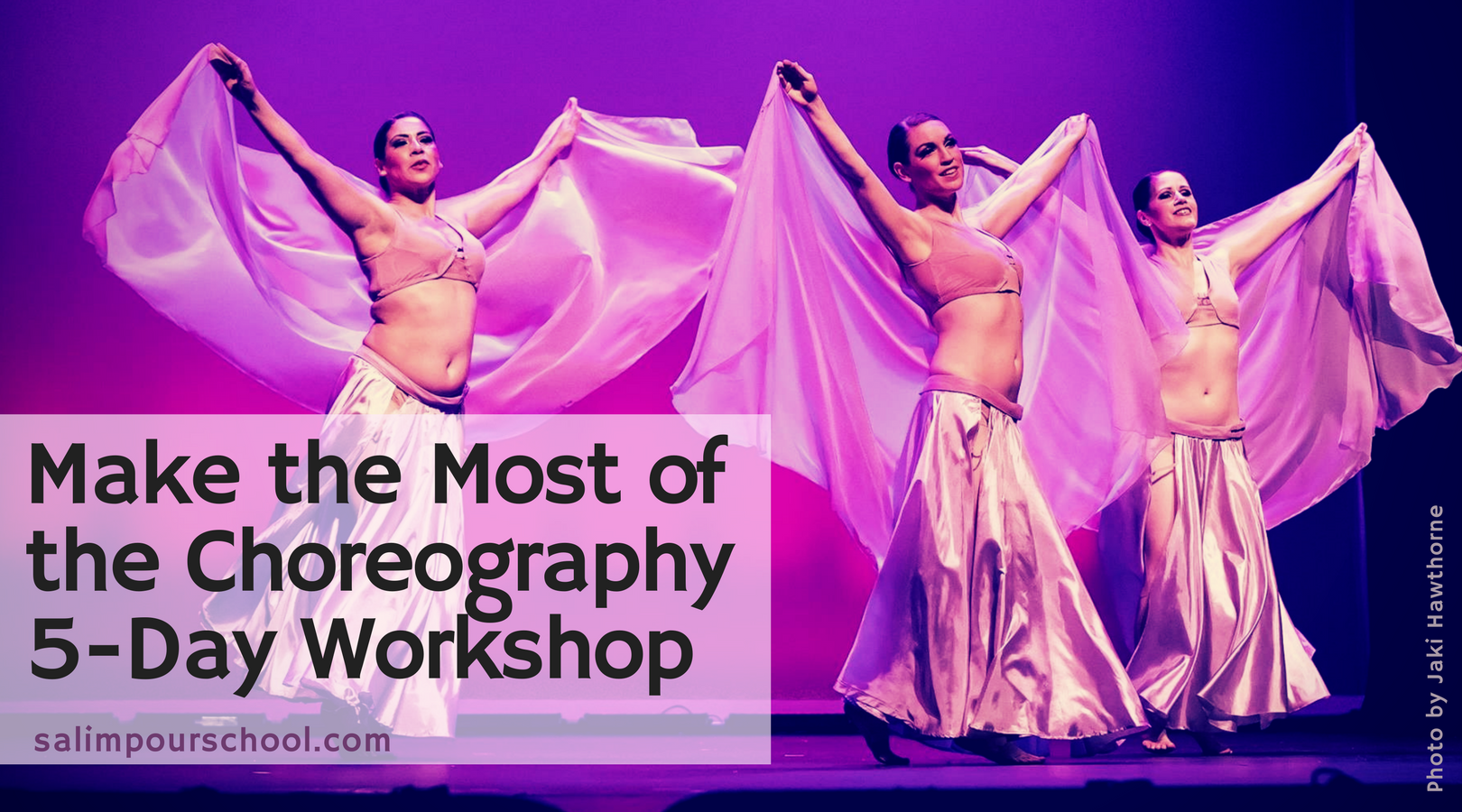By Abigail Keyes (SL5/JL5)
Creating choreography doesn’t have to be daunting, and yet for many of us it can feel like an insurmountable task. We struggle with remembering the sequence of steps we have created. Others have difficulty silencing that voice in our head that tells us that our work is too simple, not impressive enough, or just generally “not good enough.” But it doesn’t have to be that way.
In the Salimpour School, we teach dance composition in a specific way that allows for the dancer’s personal creative voice to shine… and helps the dancer overcome many of the common struggles when creating personal work.
Our education program equally values both setting choreography and improvisational skills. Suhaila often says that choreography should have look of spontaneity and freedom of improvisation, and improvisation should have the structure and practice of set choreography. One is not more worthwhile than the other. In fact, they inform each other along a spectrum.
We make sure to set you up for composition success, starting in the lower levels. Here’s a peek behind the scenes at the work we do at the Choreography 5-Day Workshop.
First, Earn Your Level 2 Certifications… And Take a Suhaila Format Level 3
Once a dancer has earned their Level 2 certification in both the Suhaila and Jamila Formats, they are eligible to attend both the Choreography 5-Day Workshop and the Improvisation and Live Music 4-Day Workshop. Both focus on the art and act of making dances within the context of Arab culture, music, sentiment, and etiquette.
We recommend that a dancer attend at least one Suhaila Level 3 Weeklong Workshop before attending both the Choreography and the Improvisation/Live Music workshops, because our exploration of dance composition truly begins there.
But even before that, we are preparing you for composition. Our standard technique classes almost always end with a combination. Here you learn how steps are threaded together, how the technique becomes a dance. In the Level 2 Weeklong Workshops, we introduce the concept and practice of “The Grid.” The Grid divides the stage and the audience each into 3×3 squares, so we can better manage our movement patterns through space on the stage, as well as our energy projection into the audience.
Beyond the Grid and learning combinations, the Salimpour School has developed a collection of invaluable tools for creating meaningful, personal, and culturally-informed dances.
Tools for Dance-Making

Author’s own tallies for two choreographies she recently created to teach. “Rompi Rompi” is available in her Turkish Stylization series on the Salimpour School Online. Click to enlarge.
Tallies: One of the tools we use to better understand the structure of a song is “tallies.” In our dance-art books (a 9”x11” sketchbook or equivalent), we tally the song to which we have chosen to choreography. Trying to choreograph a song without first tallying is putting the proverbial cart before the horse. If you don’t understand the structure of the song, the act of setting movement to it often becomes messy and frustrating.
In our Online Class library, Suhaila demonstrates how she tallies music, illustrating the structure of several songs in different genres. (Online Class subscription and Suhaila Format Level 1 certification required to view.)
The Letter: Again, in Level 3, you begin your emotional work by writing a letter to someone. That someone could be a relative, a place, or yourself in the past or the future, and you never have to show anyone else your letter. From your letter, you identify specific, visceral emotions, such as betrayal, excitement, despair, rage, or vindication.
From each emotion, you create a full-body physicalization. For despair, you might fall to your knees, your head in your hands. Excitement becomes jumping for joy, arms up raised, eyes to the sky. Rage becomes stomping with fists punching at an invisible adversary in front of you. These actions inform your intent and give emotional weight to your composition.
The Box: We also ask that you read The Creative Habit by Twyla Tharp, in which she describes how she uses a box to organize items and ideas for new work. Anything that helps to create the mood, structure, or emotional intent of the piece goes into the box. Personally, I like to add fabrics, perfumes, and keepsakes to remind me of the specific moment that my choreography is about.
Select Your Music: From the emotional intent of your letter, then you choose your music. You can choose a piece of music first, but the most successful pieces start with a story. From the story, you are better able to narrow down your music choices. You must choose a piece of classic Arabic music, preferably an original version (unless it’s Umm Kulthum, then choose an instrumental that accurately reflects the original era and sentiment). For the most recent Choreography 5-Day, I selected Jalilah’s version of “Mashaal,” but another student choreographed to the original version of “Amar 14.”
Of course, the Salimpour School has provided you with a list from which to choose, but it’s not exclusive. There are plenty of songs you could select that aren’t on this list, but it does give you a great idea of what we’re looking for.

Author’s personal collages for her choreography “Mashaal.” Color, texture, and other images help you create a feel for your piece, and eventually, design a matching costume. Click to enlarge.
Collages: Beginning in Level 2, you begin collaging in your dance-art book. Collaging seems to be a polarizing activity: some people love it, while others can’t stand it. Either way, it is a valuable tool to visualize mood, get into a creative state of flow, and create a visual reminder of the intent of your piece. Images can be from art magazines, Pinterest, or any visual medium.
Make Your Dance: Only after you’ve tallied, collected items for your box, collaged, and written your letter do you make your dance. Believe me, once you’ve completed all the steps above, creating the dance itself becomes much easier and way more fun.
Choose movements that come to you naturally. The more you force your dance, the more difficult it will be to commit to “muscle memory.” And, no matter what, just create something. It’s better to create something that you’re not 100% thrilled with than to come in with nothing at all.
Notation: In Level 2, we test you on your working knowledge of the Salimpour School nomenclature. Dancers have been trying to record their dances on paper for hundreds of years, and the Salimpour School method allows us to do so without special symbols or extensive training. My academic advisor for my Masters thesis often remarked on how revolutionary our method for notation really is.
When you create your work for the Choreography 5-Day, you must type it in Salimpour notation. While it can quite time-consuming, doing so helps you analyze your work in a different modality and keep a lasting record of your movements. Your finished choreography notes should also include both the stage and audience grids, but you’ll work on that throughout the workshop week. Notation guides are found on the “Resources” page of our website.
What the Workshop Days Look Like
Each day is a little bit different, but the bulk of our time is spent on presenting our compositions to Suhaila and whoever is assisting the workshop. Last year Sabriye Tekbilek was the assistant, but every year is different. Each dancer dances their work, and receives feedback to integrate for the next day.
We also go through the required certification choreographies for both Suhaila format and Jamila Format. Starting in 2018, you must also learn and commit to muscle memory the “Improvisation Prep” sets, as defined in the “Pre-Workshop Requirements” for the workshop. Make sure you review these ahead of time and are prepared to dance them and receive clean-up guidance from Suhaila and the teaching assistant.
Last year, we spent time on the last day reviewing an assignment on stylization. Every participant must come in with a combination of 8 counts of 8 of simple Jamila Format steps, and apply specified stylizations. It’s a great idea to start collecting videos on YouTube in unlisted playlists for your own reference, so that you can watch different Middle Eastern dance styles side-to-side, identifying what elements make each one unique.
Also be prepared to dance and drill for some of the time, with a specific focus on “Jamhaila” and SL3+ full-body dance concepts.
Start Your Work As Early As Possible
As you know, attending an advanced-level workshop at the Salimpour School requires a lot of prep work, so don’t leave it until the last minute. Start early, and work on a little bit at a time. The earlier you start, the more successful and satisfied you’ll be with your workshop experience.
The next Choreography 5-Day workshop is only a few months away… so start making those dances! We can’t wait to see what you create!






